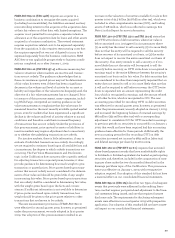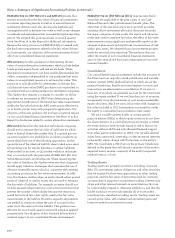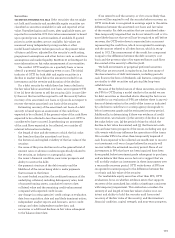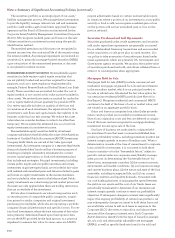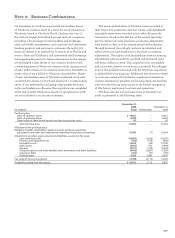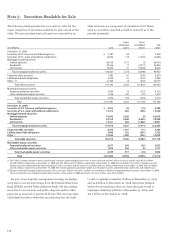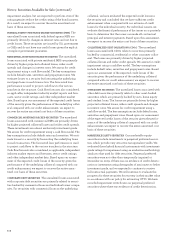Wells Fargo 2009 Annual Report Download - page 107
Download and view the complete annual report
Please find page 107 of the 2009 Wells Fargo annual report below. You can navigate through the pages in the report by either clicking on the pages listed below, or by using the keyword search tool below to find specific information within the annual report.
the SPE, subject to determining whether the entity is a VIE
and to determining who is the primary beneficiary. In these
cases, any beneficial interests that we previously held are
derecognized from the balance sheet and we record the
underlying assets and liabilities of the SPE at fair value to the
extent interests were previously held by outside parties.
The carrying amount of the assets transferred to a QSPE,
excluding servicing rights, is allocated between the assets
sold and the retained interests based on their relative fair val-
ues at the date of transfer. We record a gain or loss in other
fee income for the difference between the carrying amount
and the fair value of the assets sold. Fair values are based on
quoted market prices, quoted market prices for similar assets,
or if market prices are not available, then the fair value is esti-
mated using discounted cash flow analyses with assumptions
for credit losses, prepayments and discount rates that are
corroborated by and independently verified against market
observable data, where possible. Retained interests from secu-
ritizations with off-balance sheet entities, including QSPEs
and VIEs where we are the primary beneficiary, are classified
as either available-for-sale securities, trading account assets
or loans, and are accounted for as described herein.
Mortgage Servicing Rights
Under the Transfers and Servicing topic of the Codification,
servicing rights resulting from the sale or securitization of
loans we originate (asset transfers) are initially measured at
fair value at the date of transfer. We recognize the rights to
service mortgage loans for others, or mortgage servicing
rights (MSRs), as assets whether we purchase the MSRs or
the MSRs result from an asset transfer. We determine the fair
value of servicing rights at the date of transfer using the pre-
sent value of estimated future net servicing income, using
assumptions that market participants use in their estimates of
values. We use quoted market prices when available to deter-
mine the value of other interests held. Gain or loss on sale of
loans depends on (1) proceeds received and (2) the previous
carrying amount of the financial assets transferred and any
interests we continue to hold (such as interest-only strips)
based on relative fair value at the date of transfer.
To determine the fair value of MSRs, we use a valuation
model that calculates the present value of estimated future
net servicing income. We use assumptions in the valuation
model that market participants use in estimating future net
servicing income, including estimates of prepayment speeds
(including housing price volatility), discount rate, default
rates, cost to service (including delinquency and foreclosure
costs), escrow account earnings, contractual servicing fee
income, ancillary income and late fees. This model is validated
by an independent internal model validation group operating
in accordance with a model validation policy approved by
Corporate ALCO.
MSRsMEASURED AT FAIR VALUE We have elected to initially
measure and carry our MSRs related to residential mortgage
loans (residential MSRs) using the fair value method. Under
the fair value method, these residential MSRs are carried in
the balance sheet at fair value and the changes in fair value,
primarily due to changes in valuation inputs and assumptions
and to the collection/realization of expected cash flows, are
reported in noninterest income in the period in which the
change occurs.
AMORTIZED MSRsAmortized MSRs, which include commercial
MSRs, are carried at the lower of cost or market value. These
MSRs are amortized in proportion to, and over the period of,
estimated net servicing income. The amortization of MSRs
is analyzed monthly and is adjusted to reflect changes in
prepayment speeds, as well as other factors. Amortized MSRs
are periodically evaluated for impairment based on the fair
value of those assets. If, by individual stratum, the carrying
amount of these MSRs exceeds fair value, a valuation reserve
is established. The valuation reserve is adjusted as the fair
value changes. For purposes of impairment evaluation and
measurement, we stratify servicing assets based on the
predominant risk characteristics of the underlying loans,
including the category of the investor (e.g., governmental
agency securitization, non-agency securitization or purchased
loan servicing).
Premises and Equipment
Premises and equipment are carried at cost less accumulated
depreciation and amortization. Capital leases are included in
premises and equipment at the capitalized amount less accu-
mulated amortization.
We primarily use the straight-line method of depreciation
and amortization. Estimated useful lives range up to 40 years
for buildings, up to 10 years for furniture and equipment, and
the shorter of the estimated useful life or lease term for lease-
hold improvements. We amortize capitalized leased assets on
a straight-line basis over the lives of the respective leases.
Goodwill and Identifiable Intangible Assets
Goodwill is recorded in business combinations under the
purchase method of accounting when the purchase price is
higher than the fair value of net assets, including identifiable
intangible assets.
We assess goodwill for impairment annually, and more
frequently in certain circumstances. We have determined
that our reporting units are one level below the operating
segments. We assess goodwill for impairment on a reporting
unit level and apply various valuation methodologies as
appropriate to compare the estimated fair value to the carrying
value of each reporting unit. Valuation methodologies include
discounted cash flow and earnings multiple approaches. If the
fair value is less than the carrying amount, a second test is
required to measure the amount of impairment. We recognize
impairment losses as a charge to noninterest expense (unless
related to discontinued operations) and an adjustment to the
carrying value of the goodwill asset. Subsequent reversals of
goodwill impairment are prohibited.
We amortize core deposit and other customer relationship
intangibles on an accelerated basis based on useful lives not
exceeding 10 years. We review such intangibles for impairment
whenever events or changes in circumstances indicate that
their carrying amounts may not be recoverable. Impairment






